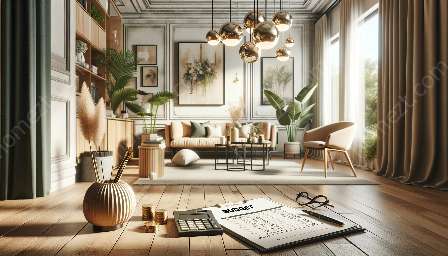Interior design and home furnishings play a crucial role in shaping the look and feel of a space. Whether you're designing a new home or renovating an existing one, budgeting and cost estimation are essential aspects of the process. In this comprehensive guide, we'll delve into the intricacies of budgeting and cost estimation, their relevance to interior design, and how to effectively manage these aspects to create stunning interiors within financial constraints.
Budgeting in Interior Design
Budgeting is the process of creating a detailed plan that outlines the estimated expenses for an interior design project. It involves allocating financial resources to various elements such as furnishings, decor, materials, and professional services.
Analyze Project Requirements: Before embarking on any interior design project, it's crucial to assess the scope of work and the specific requirements of the client. Understanding the project's goals, timeline, and desired aesthetic can help in outlining a realistic budget.
Define Budget Categories: Breaking down the budget into categories such as furniture, lighting, accessories, and labor can provide a clear overview of where the funds will be allocated, allowing for better control and monitoring throughout the project.
Research and Cost Evaluation: Researching the cost of materials, sourcing suppliers, and obtaining quotes from service providers can aid in creating a comprehensive budget that accounts for all potential expenses.
Cost Estimation Techniques
Cost estimation involves predicting the expenses associated with an interior design project based on the scope of work and the desired outcomes. Accurate cost estimation is crucial for managing project finances and ensuring its successful completion within budget constraints.
Quantity Takeoff: This technique involves measuring and quantifying the materials required for the project, enabling accurate cost calculations based on the quantities needed.
Comparative Analysis: Comparing the cost of similar projects or materials can provide valuable insights into the expected expenses, allowing for more precise cost estimation.
Utilizing Technology: Software and tools designed for cost estimation, such as 3D modeling and rendering programs, can assist in creating detailed cost breakdowns and visual representations of the project's expenses.
Effective Budget Management
Managing the budget effectively is essential for the successful execution of an interior design project. By implementing strategic measures, interior designers and homeowners can ensure that the project stays within the budget while delivering exceptional results.
Continuous Monitoring: Regularly tracking and reviewing the actual expenses against the budgeted amounts can help in identifying any deviations and addressing them promptly to prevent cost overruns.
Flexibility and Contingency Planning: Building flexibility into the budget and having contingency plans for unexpected costs can mitigate financial risks and ensure that the project remains on track.
Cost-Saving Strategies
Implementing cost-saving strategies can help in optimizing the budget without compromising on the quality and aesthetic appeal of the interior design project.
Strategic Material Selection: Choosing high-quality yet cost-effective materials can significantly impact the overall project expenses while maintaining the desired design aesthetic.
DIY and Upcycling: Incorporating do-it-yourself projects and upcycling existing furnishings can contribute to cost savings and add a personalized touch to the interior design.
Cost Estimation for Home Furnishings
When it comes to home furnishings, accurate cost estimation is crucial for homeowners and interior designers alike. Understanding the factors that influence the cost of furnishings can aid in making informed decisions and managing the budget effectively.
Factors Affecting Furnishing Costs: Quality, material, size, design complexity, and brand reputation are among the key factors that can influence the cost of home furnishings. Understanding these factors can assist in budget allocation and decision-making.
Vendor Selection and Negotiation: Researching multiple vendors, comparing prices, and negotiating favorable deals can contribute to cost savings when procuring home furnishings for interior design projects.
Conclusion
Budgeting and cost estimation are integral components of successful interior design and home furnishings projects. By carefully planning and monitoring the budget, as well as applying effective cost estimation techniques, designers and homeowners can achieve stunning results while adhering to financial constraints. Embracing creative solutions and strategic approaches to budget management can lead to captivating interiors that reflect individual style and elevate the living spaces.


